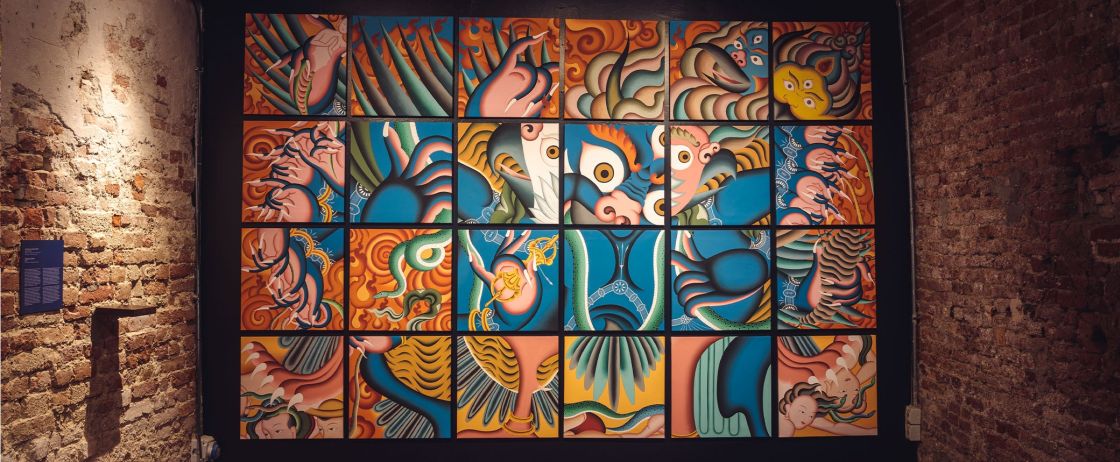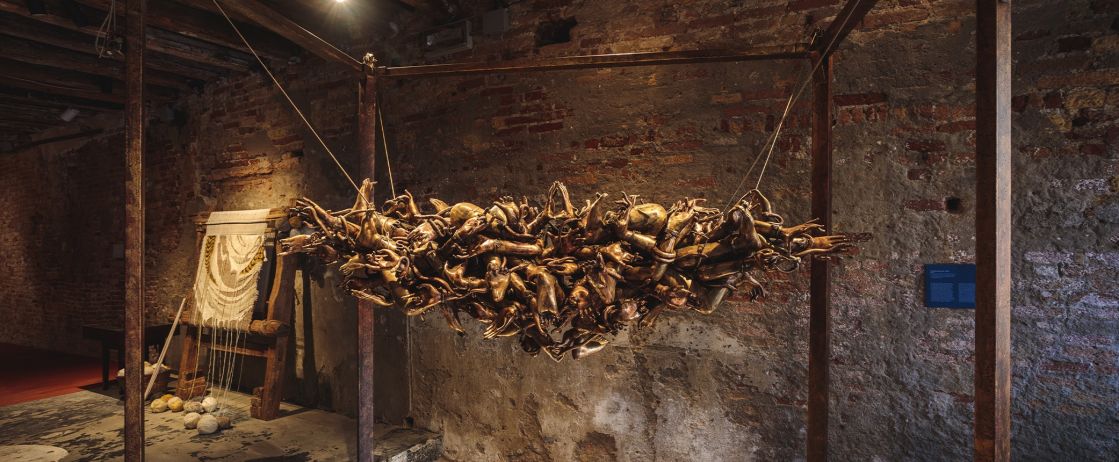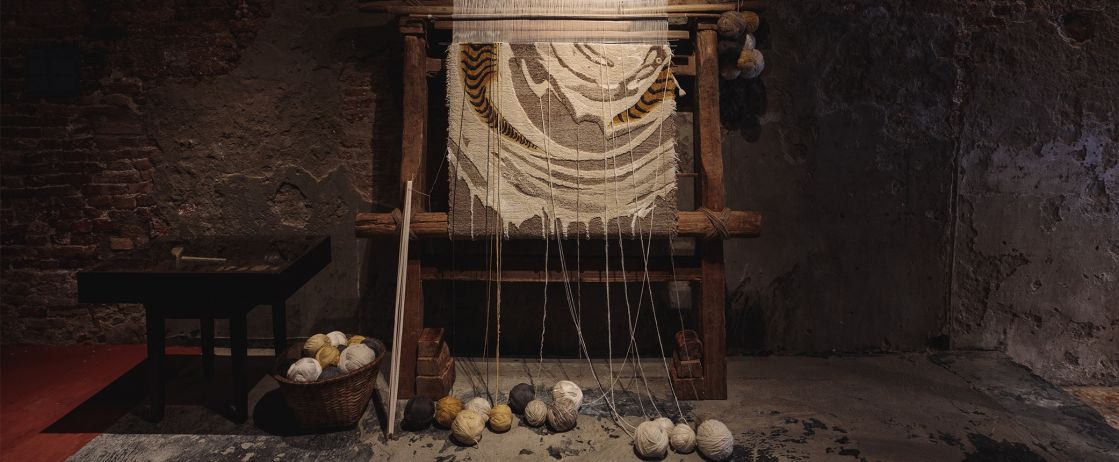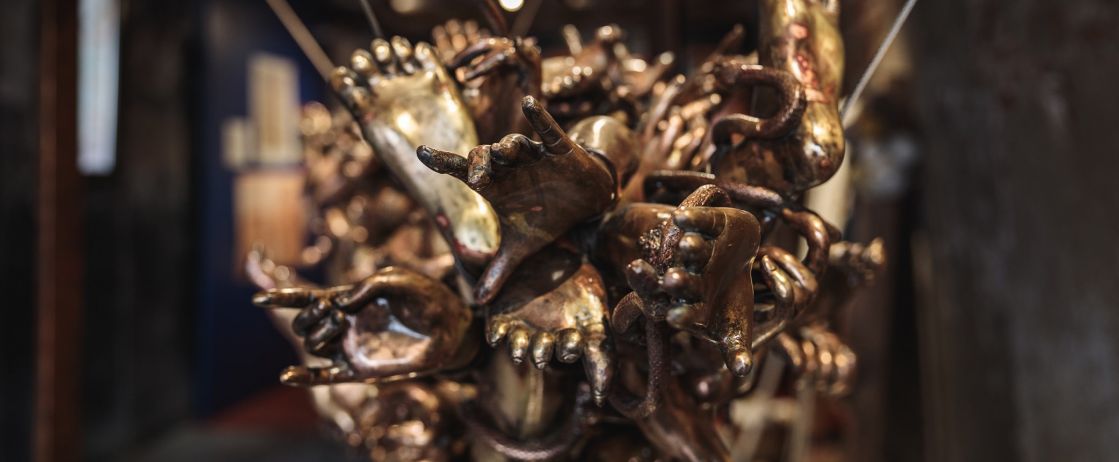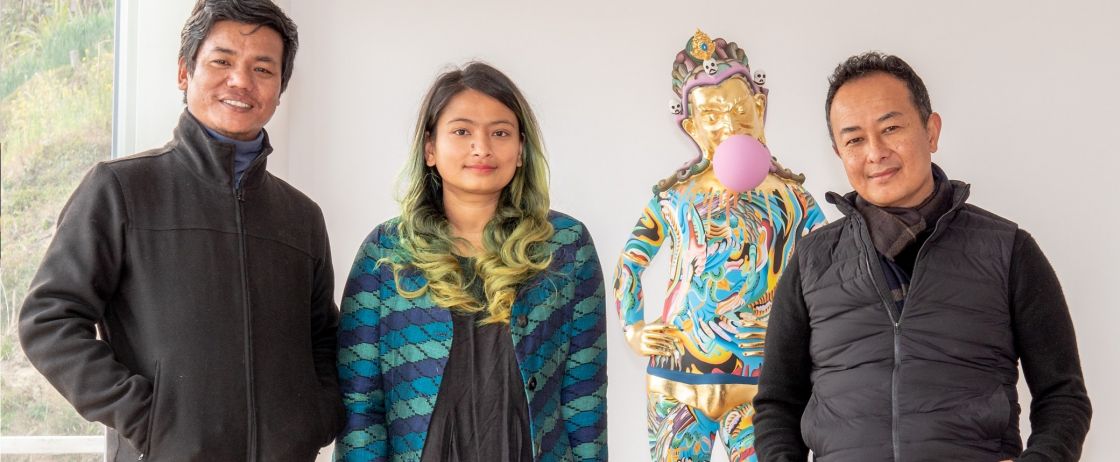
The first-ever Nepal Pavilion debuts at the 59th International Art Exhibition—La Biennale di Venezia in 2022 with Tales of Muted Spirits—Dispersed Threads—Twisted Shangri-La curated by artists Sheelasha Rajbhandari and Hit Man Gurung and featuring the work of artist Tsherin Sherpa.
Trained in the art of thangka painting, Tsherin Sherpa (born in Kathmandu, 1968) is regarded as one of Nepal’s foremost contemporary artists. For the Biennale Arte 2022, he will collaborate with artists across the country to draw upon materials from a shared history and incorporate accounts encoded in oral cultures, woven languages, and quotidian rituals to implicate an intersectional and intertwined past that problematizes contradictory conceptualizations of Nepal as well as the broader Himalayan region.
Appointed by Nepal’s Ministry of Culture, Tourism and Civil Aviation, the project is co-commissioned by the Nepal Academy of Fine Arts and the Siddhartha Arts Foundation, with lead global support from the Rubin Museum of Art.
The inaugural Nepal Pavilion will be presented at Sant’Anna Project Space One, located on Fondamenta S. Anna in the area between the Arsenale and Giardini,the two main venues of La Biennale di Venezia.
About the artist Tsherin Sherpa was born in Kathmandu in 1968, where he currently resides. He was trained in thangka painting by his father, Master Urgen Dorje, eventually drawing on this vocabulary to create artworks that incorporate Buddhist iconography and pop culture references. His works offer an interplay and tension between sacred/secular, traditional/contemporary, and settlement/movement. Sherpa’s practice stems from his personal experiences within the Himalayan diaspora as well as the nomadic history of Himalayan peoples. His experimentations with visual languages adapt, reimagine, and reappropriate identities, symbols, colors, and gestures to surpass their chronological and cultural constrictions.
He has been a part of Yokohama Triennale (2020); Yinchuan Biennale (2018); Kathmandu Triennale (2017); Asia Pacific Triennial of Contemporary Art, Brisbane (2015–16); and Dhaka Art Summit (2014). Sherpa has also exhibited at Virginia Museum of Fine Arts (2019); Rubin Museum of Art (2019); Asian Art Museum,San Francisco (2019); Weltmuseum Wien (2019); Kunstmuseum Bochum (2018); and Berkeley Art Museum (2018). His works are in the collections of Victoria & Albert Museum; Rubin Museum of Art; Queensland Art Gallery & Gallery of Modern Art; Asian Art Museum, San Francisco; Virginia Museum of Fine Arts; and World Museum, Liverpool. In 2018 he undertook a residency at the Pitt Rivers Museum, Oxford. In February 2022, the Virginia Museum of Fine Arts will present his first museum retrospective. Sherpa is represented by Rossi & Rossi in Hong Kong.
About the curators Sheelasha Rajbhandari, born in 1988 in Kathmandu, is a visual artist, cultural organizer, and cofounder of the artist collective Artree Nepal. Her longitudinal research repositions quotidian and plural narratives, by weaving folktales, oral histories, and performative rituals as a juxtaposition to conventional historiography. Rajbhandari’s practice is rooted in the experiences of women and seeks to confront how female agency and corporeality become contested political sites for contemporary nation-states, a phenomenon that parallels the dismantling of matricentric landscapes in extractive societies.
Her installation in the traveling exhibition A beast, a god and a line (2018–2020) was presented at Para Site, Hong Kong; TS1, Yangon; Museum of Modern Art, Warsaw; Kunsthall, Trondheim; and MAIIAM Contemporary Art Museum, Chiang Mai. She has also been an artist in residence at Bellas Artes Projects (2019) and Para Site (2017). She has also exhibited at Museum of Arts and Design, New York (2022); Weltmuseum Wien (2019); Serendipity Arts Festival, Goa (2017); and Kathmandu Triennale (2017). As a part of her collective, she has participated in Dhaka Art Summit (2020) and Biennale of Sydney (2020). Rajbhandari is co-curator of the Kathmandu Triennale 2077 and 12 Baishakh-Post Earthquake Community Art Project with Hit Man Gurung.
Hit Man Gurung, born in 1984 in Lamjung, is currently based in Kathmandu. Gurung’s diverse media of works are concerned with some of the most pressing political, economic, and cultural phenomena transforming Nepal’s physical and societal landscapes. His work particularly addresses the country’s decade long People’s War, several years of unstable governments, and the impact all of this has had on the personal and professional lives of Nepalese citizens. His art also speaks to the strong impact of global capitalism, the dramatic economic boom in the Middle East and Southeast Asia, an unprecedented investment in infrastructure development within the region, and an incessant demand for cheap labor. Furthermore he stitches together the various patterns of mass migrations seen across Nepal. Gurung infuses his paintings, documentary photos, videos, performances, and installations with political conviction and personal poetry.
He has participated in exhibitions at SAVVY Contemporary, Berlin (2020); Biennale of Sydney (2020); Artspace Sydney (2019); Weltmuseum Wien (2019); Kathmandu Triennale (2017); Yinchuan Biennale (2016); Para Site, Hong Kong (2016); Asia Pacific Triennial of Contemporary Art, Brisbane (2015–16); and Dhaka Art Summit (2014, 2016, 2018 ,2020). He is cofounder of artist collective ArTree Nepal and a co-curator for the Kathmandu Triennale 2077 and 12 Baishakh-Post Earthquake Community Art Project with Sheelasha Rajbhandari.
The Nepal Academy of Fine Arts (NAFA) is the umbrella organization of Nepali artists, art researchers, and art critics that facilitates the production and exhibition of artworks, as well as the study and research of various genres of arts. NAFA has two constituent parts: the Academic Council and the Academic Assembly. The Academic Assembly makes policies and programs for the development of Nepali arts, while the Academic Council executes them in association with Nepali artists and in collaboration with other art organizations. It also monitors various art activities in the country, evaluates artworks, and grants awards to Nepali artists.
After the first Kathmandu Arts Festival in 2009, the Siddhartha Arts Foundation (SAF), a nonprofit organization, was founded in 2011 with the mission to promote Nepal’s arts and cultures, while establishing Kathmandu as a center for socially aware art practices. Since then, SAF hosted the 2012 Kathmandu Arts Festival, the 2017 Kathmandu Triennale, and Kathmandu Triennale 2077, developed in collaboration with curatorial and educational input from experts in the field selected and invited by a diverse board. Over the years, SAF has partnered with many artists, art institutions, and a broad network of national and international collaborators to host exhibitions, workshops, and art projects. SAF has been engaged in over 60 programs since its founding, and alongside the Siddhartha Art Gallery, has a combined history of over 35 years investing in Nepal’s art scene. SAF furthermore runs an education program to train art managers, curators, and critics through its Siddhartha Arts Foundation Education Initiative (SAFEI).
Photo: Chhiring Dorje Gurung
Image Credit:
Tsherin Sherpa, Preservation Project No. 1, 2009, acrylic and pigments on paper, 83.8 x 109.2 cm (33 x 42 in.), Courtesy of the artist and Rossi & Rossi
Send Your Comments
Comments are moderated, and will not appear on this site until the Rubin has approved them.

